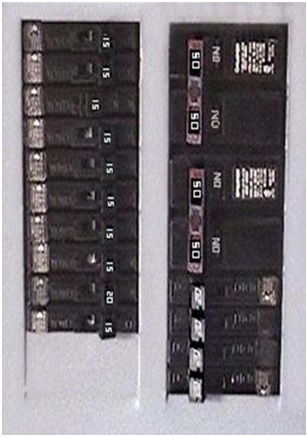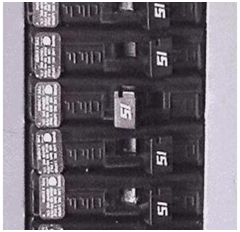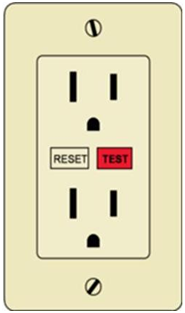Before completing the maintenance request form on RentVine, please search through the Frequently Asked Questions. Clicking this link can save you unnecessary maintenance charges!
Please make sure to look through the FAQs page first. In some cases, tenants may be charged for a service call if it is determined that it was caused by tenant neglect or if the tenant failed to perform routine maintenance. For example, if a tenant calls and states that their dishwasher is not working and the maintenance technician finds that the only problem was a tripped breaker, the tenant would be charged.
A circuit breaker provides protection by stopping the flow of electricity if an overload or fault occurs. When an electrical fault occurs or the load on your circuit becomes too great, the breaker on that circuit trips and interrupts the flow of current to that circuit. A tripped circuit breaker is still sometimes referred to as a "blown fuse" in reference to the older technology that circuit breakers replaced. If your home uses an actual fuse and not a circuit breaker, click here for information on fuse boxes.
Before electricity can be restored, the circuit breaker must be reset. However, even before you do that, you must take steps to ensure that it is safe to do so. Turn off or unplug all of the devices that are plugged into the circuit. Make certain no dangerous condition exists before restoring power. A Circuit Breaker which has been tripped will either be in the middle or "OFF" position. Locate the tripped circuit breaker and reset it by pushing it all the way to the "OFF" position and then back to the "ON" position. Often when you can't cannot reset the circuit breaker, it is because it must be turned all the way to the "Off" position first.
Electricity should now be restored to the circuit. If the circuit breaker trips again before you have turned anything on or plugged anything in, please submit a maintenance request to First Rate Property Management immediately.
If no circuit breakers were tripped and you still do not have power at an outlet, the circuit is probably on a GFCI.
A GFCI (Ground Fault Circuit Interrupter) outlet is a device that adds a greater level of safety by reducing the risk of electric shock in locations such as bathrooms, kitchens, laundry rooms and outdoors.

A GFCI outlet may be wired in a branch circuit, which means other outlets and electrical devices may share the same circuit and breaker (or fuse). When a properly wired GFCI trips, the other devices down the line from it will also lose power. Note that devices on the circuit that come before the GFCI are not protected and are not affected when the GFCI is tripped.
If you have an outlet that doesn't work, and the breaker is not tripped, look for a GFCI outlet which may have tripped. The non-working outlet may be down line from a GFCI outlet. Note that the affected outlets may not be located near the GFCI outlet, they may be several rooms away or even on a different floor. Pressing the "Reset" will restore the circuit. If the outlet doesn't reset, then whichever appliance that is causing it to trip, may still be plugged in. If after unplugging everything, checking the circuit breaker or fuse, and resetting the GFCI does not work, please submit a maintenance request to First Rate Property Management right away.
If you have an older home, you may have fuses as opposed to circuit breakers. Located inside or outside of your home is a fuse box that contains a fuse for each of your home's circuits. A fuse provides protection for each of your circuits. When an electrical short occurs or the load on your circuit becomes too great, the fuse on that circuit burns out and breaks the circuit; this is what is referred to as a "blown fuse".
Before electricity can be restored, the fuse must be replaced with a new fuse. However, even before you replace the fuse, you must take steps to ensure that it is safe to do so:
Electricity should now be restored to the circuit. If the fuse blows again before you have turned anything on or plugged anything in, submit a maintenance request to First Rate Property Management right away.
If the fuse blows after plugging in or turning on a device, that device may have a short or may be placing too much of a load on the circuit.
If no fuses were blown and you still do not have power at an outlet, make certain that the switch, if any, that controls the outlet is turned on. If you can find no problem, the outlet, switch, wiring or some other component may be at fault. Also, the outlet may be on a GFCI branch circuit.
Follow this link to troubleshoot various issues: https://www.hometips.com/repair-fix/garbage-disposal-problems.html
Disposal not working, no noise: |
|
Disposal hums or is jammed: |
|
Disposal grinds poorly: |
|
Immediately leave the home and call 911 or Intermountain Gas
If safe to do so, proceed with the following:
Don’t operate any electrical switches or create any flames - this includes flicking on a light switch. Make sure you’ve turned off the oven and fireplace as well.
Open windows and external doors immediately to allow the escape the premises.
To switch off the gas, locate the shutoff or meter and turn the lever so it's at 90 degrees to the gas pipe, closing the valve. We always suggest finding these important locations when first moving in.
Let your neighbors know if you think they may be affected by the leak – it’s better to be safe than sorry!
If you’ve evacuated the premises, don’t let anyone other than the engineer back into the property. Wait to be given the all clear before going back inside. If you feel unwell, it's best to visit your health clinic or hospital. Let them know about the gas leak so they can treat you accordingly.
Turning On the Gas Supply
Remove the decorative cover of the fireplace to reveal the gas controls at the bottom of the unit, near the floor. You should see a gas shut-off valve. Turn the handle parallel to the direction of the gas pipes to turn on the gas. If you don't see the valve, it is probably behind the fireplace. Look for it there and turn it on. Pull the fixed glass assembly off of the fireplace, if yours has one. This is an important safety precaution that prevents the buildup of gas should the pilot be hard to light.
Note: If your fireplace has a secondary gas shutoff, make sure it is all the way open. These valves are typically located outside the fireplace (to the side or on the floor) and are operated with a special key.
Lighting the Pilot
Locate the gas control knob, which should have settings for "Pilot," "On," and "Off." Look around for a red or black button; this is the piezoelectric spark igniter. Press the button a few times to verify that there it creates a spark at the end of the pilot tube. This spark will ignite the pilot flame.
Turn the gas control knob until the "Pilot" setting lines up with the arrow or hash mark on the outer rim of the control. Press and hold down the gas control knob, then press the igniter button multiple times, as needed, until the pilot flame ignites. Once the pilot lights, keep holding down the gas control knob for 20 to 30 seconds to allow time for heating up the thermocouple (a safety device), then release the knob so it pops back up. If the pilot doesn't light, release the gas control knob so it pops back up and stops the flow of gas. Wait 10 seconds, then repeat the lighting process until the pilot starts.
Turn the gas control knob to the "On" position, then replace the fixed glass assembly and the decorative cover.
As a reminder, one of your Resident Protection Package benefits is air filter delivery. The filter for your unit will be at your doorstep every 60 days! We ask that tenants change their filter as soon as possible once these are delivered.
Before calling in your problem or making a work order request, please check the below possible options:
If you’ve checked all the above and you still do not have air conditioning, please submit an online maintenance request.
Before calling in your problem or making a work order request, please check the below possible options:
If after checking the above and you still do not have heat, please submit an online maintenance request. Within the request, please annotate the condition of your furnace filters and the status of any steady or blinking red lights.
Before calling in your problem or making a work order request, please check the below possible options:
If after checking the above and you still do not have heat, please submit an online maintenance request. Within the request, please annotate the condition of your furnace filters and the status of any steady or blinking red lights.
The best ways to unclog drains can be done with common household items, such as hot water, or a mixture of vinegar and baking soda. You can also use a zip strip, which can be purchased at any home goods store if you weren’t provided one at move in. Use products like Draino as a last resort, as they are corrosive to older pipes with repeated use. You can also follow the tutorials below:
| Symptom | Possible Solutions |
|---|---|
| Dishwasher does not work - no sound, water or lights |
|
| Dishwasher does not start but motor hums | Submit a maintenance request to First Rate Property Management |
| Dishwasher does not fill with water or it drains while filling |
|
| Water does not drain from the dishwasher |
|
| Dishwasher is leaking water or soap leaks around the door |
|
| Dishwashers not cleaning properly | Get cleaning agent product from WL May called Glisten or Affresh cleaning tablets which can be purchased at Walmart, Lowes, etc. If you used the wrong soap in the dishwasher, please follow the steps listed here: External Link: I put the wrong soap in the dishwasher -- now what? |
| Door does not close or latch properly |
|
| Dishwasher cycle does not complete | Let the dishwasher complete the cycle wherever it is at, then re-start a new cycle and it should clear itself. |
| Detergent cup does not open | Check and clean the detergent cup for obstructions |
| Dishes are not cleaned adequately |
|
Locate the cutoff valve closest to the fixture.
Most fixtures will have an individual shut-off located beneath the fixture. It will likely be a chrome valve. Sinks and showers may have two valves, one for hot and one for cold. Turn both these valves clockwise until valve is closed.
· Some appliances, such as washing machines, dish washers, and refrigerators, may have a water shut off switch on the body of the appliance or on the hose connecting the appliance to the wall.
· To find the shut off for a water heater, look for a water cutoff valve directly above the heater on a connected pipe.
Identify the main shut off valve.
This is usually a brass valve that has a round handle. In most homes, it is located near the main water pipe leading into your home. Common locations for this pipe include garages, basements, crawl spaces, or a utility room. FRPM will provide this location before a new tenant moves into a vacant property.
Always shut off the valve that's closest to the inside plumbing, as opposed to the valve that's closer to the street.
Please regularly test your smoke detector and maintain with the steps listed here: External Link: Testing smoke detector / maintenance
All properties have smoke detectors. Properties with gas burning appliances, a fireplace, or an attached garage should have a CO/Smoke combo.
They are usually clearly labeled if they detect carbon monoxide as well as smoke/fire.
Smoke detectors have 2 alarms that mean different things:
See below for false alarms:
If your garage door isn't closing all the way, you may have a problem with the alignment of the sensors at the bottom corners of the garage door. This may occur if anyone has accidentally bumped into them. For a video of how to properly align your garage door, go to this link: https://www.youtube.com/watch?v=gHIytLm0iAU
Per your rental agreement, treatment of household pests is the tenant’s responsibility. One way to minimize the possibility of pests is to keep a tidy home. Homes that are not so tidy, offer a food source as well as shelter for many pests. So if you discover any pests, your first step would be to do a thorough cleaning of the entire home. This eliminates the food source.
If the problem continues, most grocery or hardware stores carry traps and sprays that should resolve your problem in a few days. We find that ant traps can solve the problem in just a few days. These traps are filled with poisoned bait. The reason the ants are in your house is because they found food. The ant trap baits them, then they take the poisoned food back to the nest and they die. Some of the sprays are very good for spiders, roaches, and bed bugs. If the problem continues, please feel free to contact us. We’ll have to do an inspection to make sure that the home is tidy and see what remedies you had already tried and failed with.
If you are on the Resident Protection Package, your pest control needs are covered. Please contact the pest control vendor using the contact information provided to you at move in.
We are excited to work with you! Please let us know what you have in mind and we will be happy to discuss further.

1251 N. Cole
Boise, ID 83704
208.321.1900
info@Idahofirstpm.com
Monday: 11am-1pm & 2pm-5pm
Tuesday: 11am-1pm & 2pm-5pm
Wednesday: 11am-1pm & 2pm-5pm
Thursday: 11am-1pm & 2pm-5pm
Friday: Appt. Only
Sat & Sun: Closed
After Hours: 208.321.1900
Copyright © 2023 For Idaho First. All Right Reserved.
Idaho First Property Management is committed to ensuring that its website is accessible to people with disabilities. All the pages on our website will meet W3C WAI’s Web Content Accessibility Guidelines 2.0, Level A conformance. Any issues should be reported to info@idahofirstpm.com.